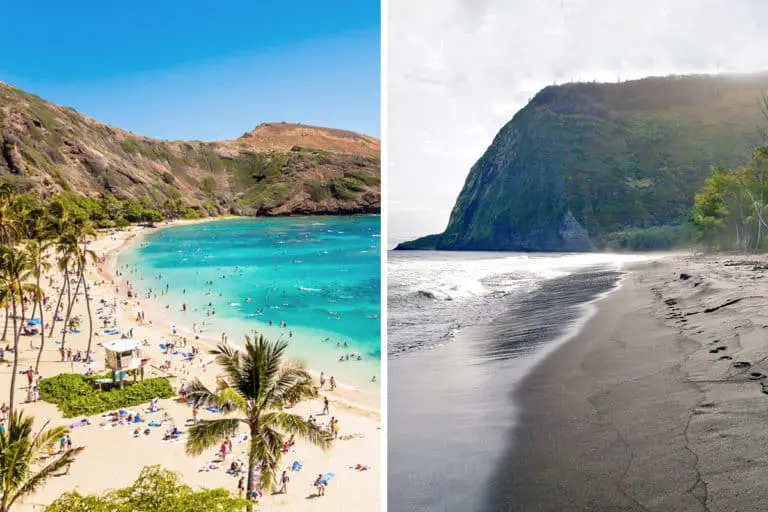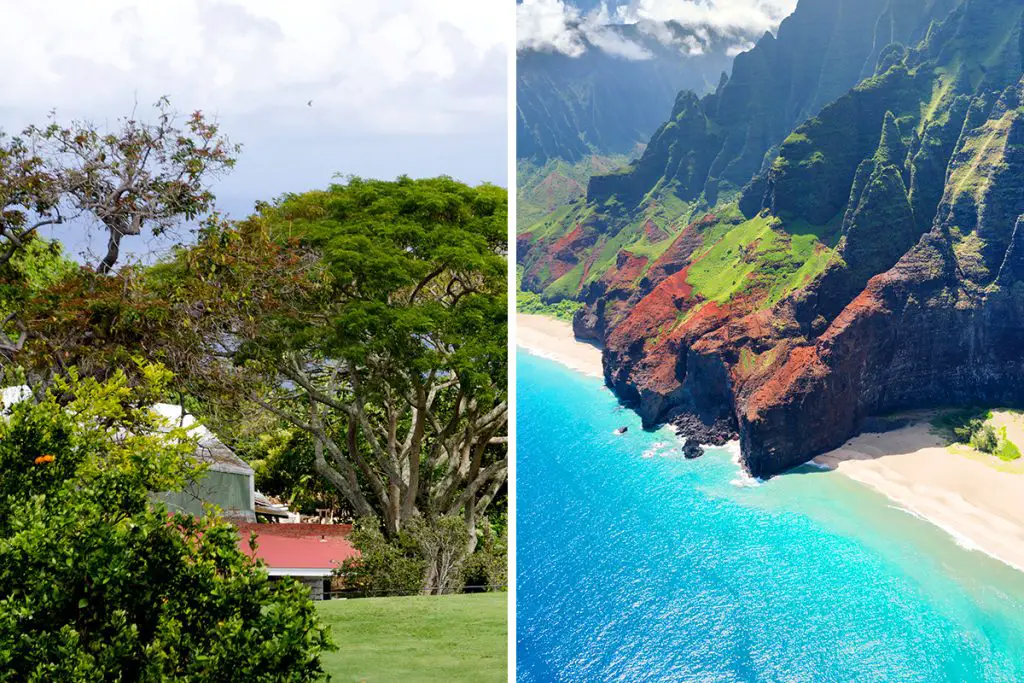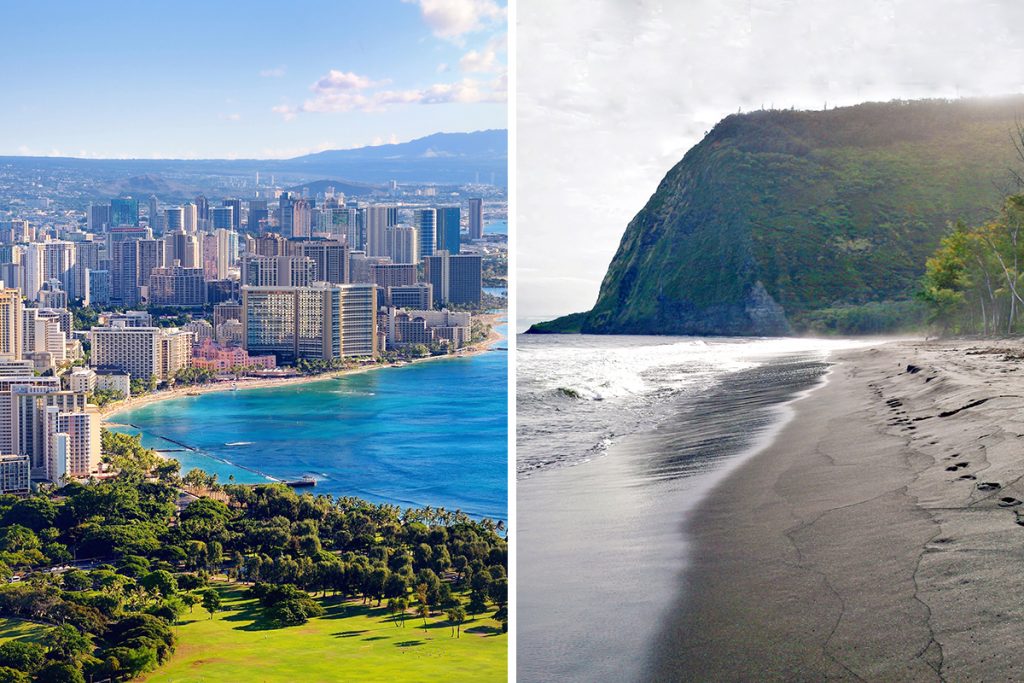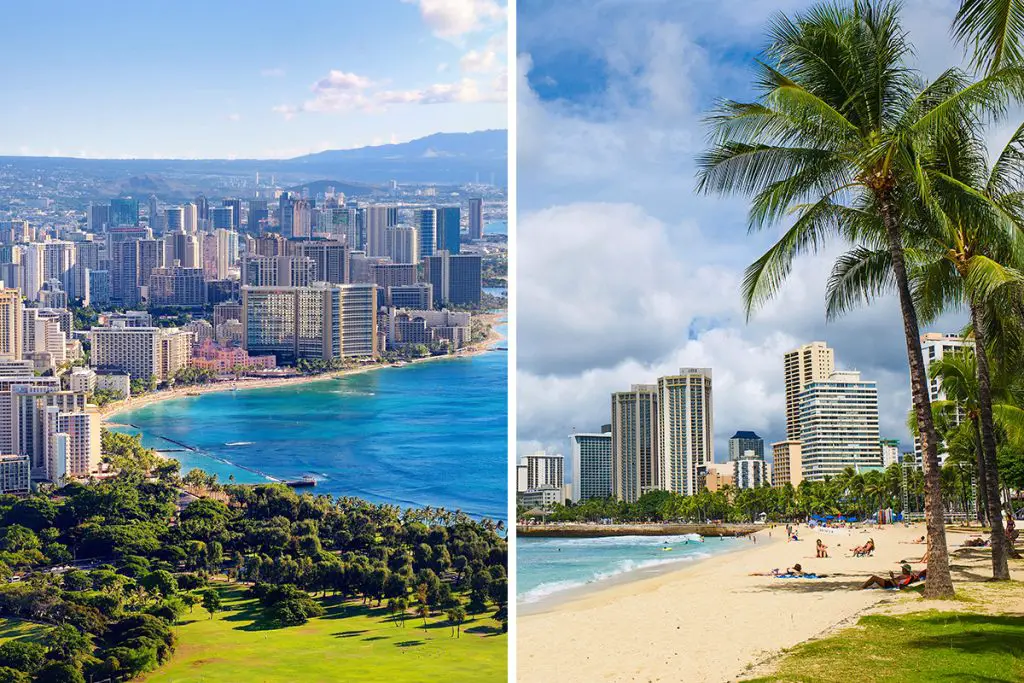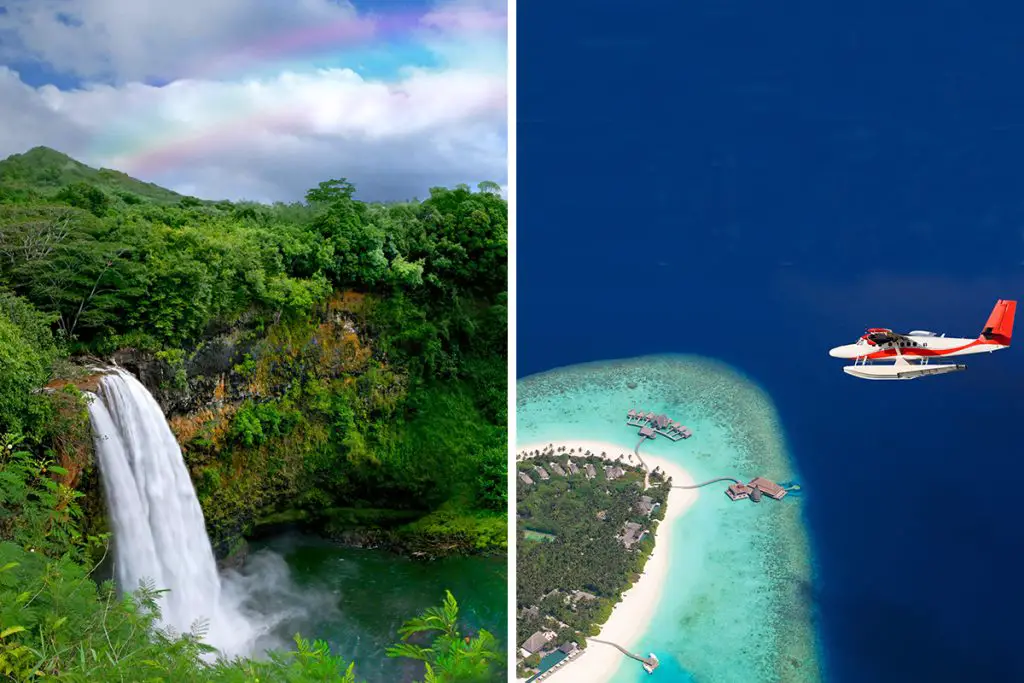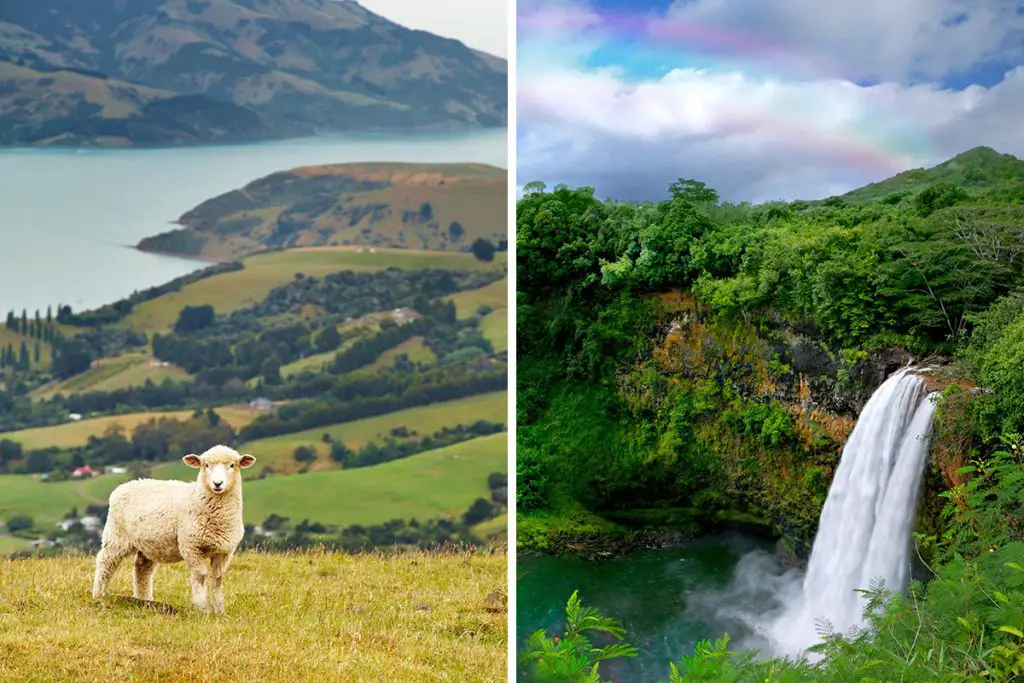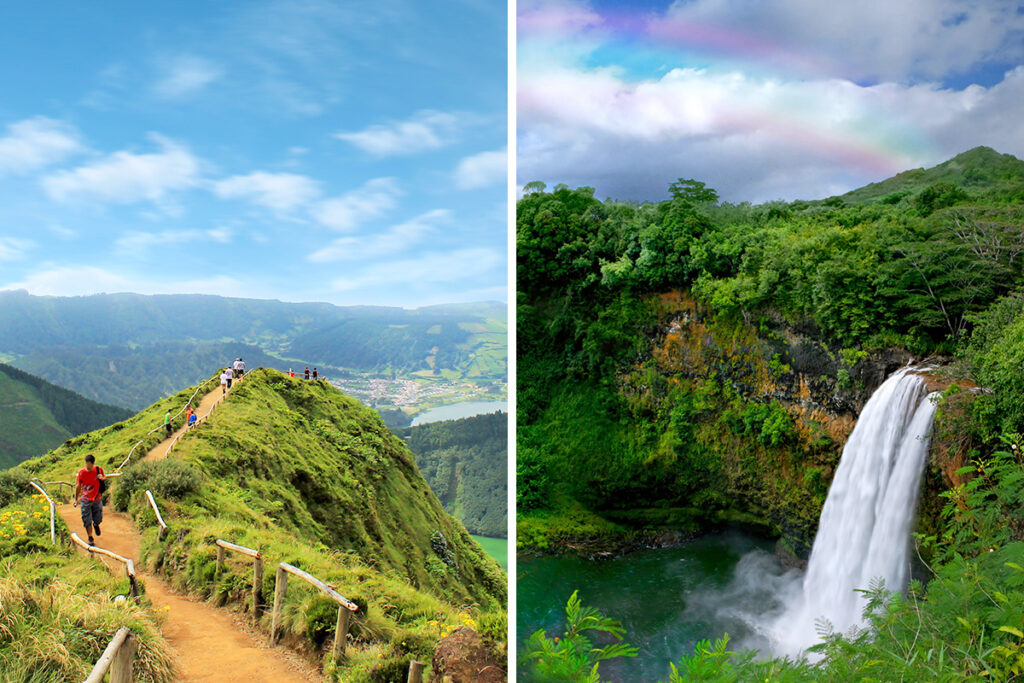Much like it is called, the Big Island is the largest among the Hawaiian islands. It is located on the far right of Hawaii’s territory and is primarily known for its numerous volcanoes.
On the other hand, the island of Oahu sits right in the middle of Kauai and Maunaloa. It is often considered the epitome of a Hawaiian paradise. It features white-sand beaches lined with high-class hotels and resorts. Oahu is also known for its history with Pearl Harbor and the local Polynesian communities.
Oahu
Oahu is the third-largest major island in the US state of Hawaii. It is located in between the islands of Molokai and Kauai. Although Oahu is not the largest Hawaiian island, Oahu is home to the majority of Hawaii’s population.
Oahu is also known as one of the most visited islands in Hawaii. The beautiful island draws millions of visitors each year. The capital city of Honolulu is located along the island’s southern coast. It serves as the primary tourist hub in the region.
Locally referred to as “The Gathering Place”, Oahu is a melting pot of cultures. The cosmopolitan city is influenced by the American culture while quaint surf towns throughout the island embody native Polynesian cultures.
What Makes Oahu Unique?
Hawaii’s Paradise Island
Oahu’s tourism is more than just its metropolitan areas. Many travel to the island to appreciate its rather untouched natural beauty. From massive mountain ranges, vast valleys, world-class beaches, and a unique volcanic cone, Oahu’s beauty is a must-see attraction in Hawaii.
Diamond Head
The Diamond Head State Monument is considered to be the most popular tourist attraction in Oahu. It features the grandiose Diamond Head, a massive volcanic cone located by the southeastern coast of the island. It sits beautifully at the end of Waikiki’s coast and serves as a beautiful backdrop to the city’s skyline.
Drawing thousands of tourists daily, the site allows visitors to walk along a dormant volcano’s crater at 232 m (764 feet) above sea level. The Diamond Head State Monument features a trail that was once part of the army’s coastal artillery defense system. It normally takes 1.5 to 2 hours to complete a round trip of the 2.5 km (1.6 mi) trail of the ridgeline.
Considered Oahu’s most iconic and prominent geological feature, the unique trail experience is accompanied by panoramic views of the city and Oahu’s eastern coast. From there, it is easy to spot the nearby islands of Molokai and Lanai on a clear day.
Hanauma Bay
The Hanauma Bay is a beautiful stretch of white sand and turquoise blue waters located on Oahu’s eastern coast. The wineglass-shaped bay is part of a nature preserve that protects the area’s coral reef and marine life.
The bay is also home to some of the most beautiful reefs in shallow waters. Snorkeling spots in Hanauma Bay are beginner-friendly since the ocean is typically calm and gentle.
Waimea Valley
The Waimea Valley features some of Oahu’s most majestic landscapes. Located along Oahu’s north shore, the valley is also known for its cultural and historical significance to Hawaii. The site is home to an expansive botanical garden as well as the largest temple in Oahu.
Referred to as the “Valley of the Priests’, the nature park’s highlight is the majestic Waimea Falls. Many also appreciate the lush greens and outdoor botanical garden. It features 35 distinct collections including some of the island’s native plant and flower species.
Wondrous Heights for Scenic Views
There are several ways to appreciate Oahu’s beauty. If the famous Diamond Head trail is too challenging, there are numerous undiscovered spots that tourists can visit to indulge in the island’s wondrous beauty.
Makapu’u Lookout
The Makapu’u Lookout is located right along the Kalanianaole Highway. Located within the Makapu’u Point State Wayside Park in southeastern Oahu, the lookout is an accessible spot for visitors. The lookout offers expansive views over the island’s southeastern coast.
Getting to the lighthouse requires a short hike but will reward a clear view of the nearby Molokaʻi, Maui, and even Lānaʻi. It is also possible to spot some whales around the area during Hawaii’s whale season from December to May.
Nu’uanu Pali Lookout
If you’re tired of the beach and the sea, the Nu’uanu Pali Lookout is the best spot for scenic views of Oahu’s grandiose mountain ranges. The scenic lookout is a quick stroll at the top of the Pali Highway, roughly 8 km (5 miles) of downtown Honolulu.
The Nu’uanu Pali Lookout provides panoramic views of the Koʻolau mountains, Kailua, Mokolii, the Kaneohe Marine Corps Base, Coconut Island, and the Hoomaluhia Botanical Garden.
Remnants of the Historic Pearl Harbor
The Pearl Harbor National Memorial is the most visited tourist attraction in Hawaii. Drawing millions of visitors each year, the memorial commemorates one of the United States’ most pivotal moments. Pearl Harbor is typically used to refer to the island’s collection of tourist attractions related to the historic event.
USS Arizona Memorial
The USS Arizona Memorial draws nearly two million visitors each year. The site is built over the remains of the USS Arizona, one of the many battleships bombed during the Second World War.
A boat ride takes tourists to the memorial site and allows visitors to see parts of the once grandiose battleship. The building in the middle of the ocean serves as a memorial and displays the names of the 1,177 crewmen who died during the attack.
Pearl Harbor Aviation Museum
The Pearl Harbor Aviation Museum features a collection of aircraft and artifacts dating back to the World War II era. Located within Ford Island, the museum allows visitors to learn about America’s aviation history. It also traces the country’s involvement during World War II, Korean War, Vietnam War, and the Gulf Wars.
USS Oklahoma Memorial
The USS Oklahoma Memorial features a shrine that commemorates the soldiers who died during the bombing of Pearl Harbor. Founded in 2007, the site features a series of white marble posts that serves as shrines for the departed. A large black granite display lists the names of the 425 servicemen who died during the attack.
USS Bowfin Submarine
The USS Bowfin Submarine Museum & Park is part of Hawaii’s sought-after Pearl Harbor National Memorial. The museum features an expansive collection of artifacts onboard the historic submarine. Visitors can explore the 312-foot- or 95 m long submarine and learn through the numerous galleries and exhibits on site.
Hawaii’s Historic and Cultural Center
The island of Oahu is more than just its scenic beauty. Aside from the beaches and mountains, Oahu is also home to several historic and cultural attractions.
Iolani Palace
Located in the capital city of Honolulu, the historic Iolani Palace is known as the royal residence of the last monarchy of Hawaii. Covering a total area of 10.6 acres (4.3 ha), the site is listed as a National Historic Landmark.
Restored to its current beauty, the site features the palace known for its American Florentice architecture. Visitors can explore the palace which houses several exhibits. This includes the Grand Hall, Throne Room, Blue Room, Music Room, Imprisonment Room, Queen’s Bedroom, and King’s Library.
Polynesian Cultural Center
For tourists looking for a way to experience and learn about Hawaii’s Polynesian roots, the famous Polynesian Cultural Center is the best place to be. The site features six traditional villages that serve as living museums and exhibits.
Considered one of Hawaii’s top tourist attractions, visitors also seek the center’s infamous evening show. It includes amazing performances featuring more than 100 Polynesian artists.
Big Island
Hawaii’s Big Island is not as popular with tourists compared with Oahu. However, traveling and exploring the majestic island is still something anyone could enjoy. Although the Big Island is the largest major island in Hawaii, it is not the primary tourist hub in the region.
Because of the island’s active volcanoes, commercial and residential development on the island did not flourish. Only home to less than 200,000 people, Big Island is primarily known for its grandiose and unbelievable landscapes. Tourist attractions on the island include black sand beaches, lava-spitting volcanoes, and national historical parks.
What Makes Big Island Unique?
Close Encounter With Volcanoes
Established in 1916, the renowned Hawai’i Volcanoes National Park covers a whopping 333,000 acres (134,760, ha.) by the southeastern coast of the island. Widely considered the most visited site on Big Island, the national park is home to Kilauea, the world’s most active volcano. The massive volcano has been continuously producing and spewing lava, making it a sought-after sight for tourists.
Those visiting the national park can take scenic trails to best appreciate the volcano’s majesty. Throughout the park, visitors can spot the Steam Vents and Supluh Bank, the Thurston Lava Tube, and the Kilauea Iki Overlook. The park also features the Jaggar Museum which provides an overview of the island’s volcanic activity throughout the years.
Trip Closer to the Heavens
The Big Island is home to the highest peak in the state of Hawaii. Standing at 13,803 feet (4,207 m), the Mauna Kea is one of the tallest peaks in the world. Its summit is a popular spot for sungazing and stargazing.
Mauna Kea’s visitor center is easily accessible by car. However, tourists wanting to reach its peak require a 4×4 vehicle in order to maneuver through the rugged and steep terrain.
Mauna Kea’s summit is recognized as one of the best places to stargaze in the world. Its topographical and average weather conditions provide an unobstructed view of the skies. This prompted the establishment of several privately-owned astronomical research facilities and observatories near the mountain’s peak. Unfortunately, these sites are not open to the public.
However, several local astronomers and enthusiasts frequent Mauna Kea at night and offer telescope viewing for tourists
Black-Sand Beaches
Big Island’s unique landscape and geography gave birth to some unique sights. The island features several black-sand beaches created by years of volcanic activity.
Punaluu Beach
The Punaluu Beach is considered one of the most famous black beaches on Big Island. Situated right between Pagal nad Na’a’ehu along the island’s southeastern coast, the palm-lined beach is a unique sight to see.
Punaluu Beach is the most developed and tourist-friendly black-sand beach on the island. It features relatively gentle waters but lifeguards are regularly on duty to supervise and assist swimmers.
Aside from the unique black sand, Punaluu Beach is also known for the frequent sightings of green and hawksbill turtles around the area. Although visitors are strictly prohibited from touching the turtles laying by the beach, they can still view them from a distance.
Kehena Beach
The Kehena Beach is a hidden gem along Big Island’s eastern coast. Fairly few come and visit the site since access requires a challenging hike along the rugged coastline. Given its relatively isolated location, Kehena Beach is designated as a clothing-optional beach, allowing visitors to strip naked.
Culture and History Entangled With Natural Beauty
Other than its scenic beauty, Big Island also boasts of its rich cultural heritage and long history. Tourists can visit national historical parks that celebrate the island’s Polynesian culture and traditions.
Kaloko-Honokohau National Historical Park
Covering over 1,100 acres (470 ha), the Kaloko-Honokohau National Park is one of the most popular archaeological sites on the island. Founded in 1978, the park stretches along the western coast of the island. It features several walking trails that pass through different sections of the historic site.
The highlight of the national park is the well-preserved Honokohau settlement that has been listed as a National Historic Landmark.
Puuhonua-o-Honaunau National Historical Park
The Puuhonua-o-Honaunau National Historical Park is located in the Kona District. The 180- acre (72 ha) historical park is considered one of the most historic and sacred sites in Hawaii.
Earlier Hawaiian culture requires individuals who broke the law to seek refuge and receive absolution through a sacred ceremony. The Puuhonua-o-Honaunau served as a place of refuge and features pieces of evidence of these activities.
Is Oahu or Big Island Better?
Although Oahu and Big Island are both in Hawaii, tourists traveling to either island may have different experiences. Oahu is considered a cosmopolitan island with the much-developed city of Honolulu at the center of its tourism. On the other hand, neighboring islands such as the Big Island offer a much more rural and quaint take on the Hawaii experience.
Oahu is home to some of Hawaii’s most beautiful beaches. It features a long stretch of palm-lined beaches with soft white sand and clear blue waters.
Oahu also is home to majestic mountain ranges and lush valleys. The grandiose Diamond Peak provides unmatched panoramic views of the island. On the other hand, the Waimea Valley takes visitors on a unique trip into heavy jungles and untouched forests.
The island of Oahu is more than just its natural scenic beauty. It is also home to several historic and cultural attractions. The infamous Pearl Harbor National Memorial provides tourists a glimpse of the island’s long history. The Polynesian Cultural Center allows visitors to celebrate Hawaii’s culture and traditions.
Big Island’s charm focuses on its ruggedness. Its extensive volcano excursions and activities are enough to fulfill anyone’s dream. The island’s array of world-class water adventures is also sure to draw thrill-seeking tourists. But aside from that, Big Island also offers unique black-sand beaches and immersive historical and cultural parks.
If you are looking for an all-in-one Hawaiian vacation, Oahu is the island paradise for you. But, if you’re seeking a once-in-a-lifetime adventure experience, then Big Island’s majestic beauty would be the perfect choice for you.
FAQs
Is Oahu or Big Island Cheaper?
Budget is one of the first things people consider when choosing a place to travel. Typically, tourists set particular budgets for food, transportation, and accommodation. Knowing the average price for each can help people choose between Oahu and Big Island.
Oahu is a much more developed tourist hub than Big Island. The majority of its southern coast is lined with beach hotels and resorts. Although there are several luxury resorts in Oahu, there are also options for budget accommodations.
On the other hand, Big Island features much fewer accommodation options. The average daily rate for a hotel room in Oahu is around $240, while Big Island ranges at around $270. This is based on Hawaii’s official tourism website.
Renting a car is also a common practice for tourists visiting Hawaii. It usually costs $50 to rent a car for a day in Oahu.
On the other hand, car rentals on Big Island are pricier since people opt for an intermediate or mid-size car instead of just a sedan. This is because mid-size vehicles are better suited for Big Island’s rugged and steep landscape. Renting an intermediate car in Big Island costs around $70 per day.
The budget for food and activities depends on the person’s spending habits. It’s possible to spend less on food by eating in local restaurants or street vendors. Regardless, the average price for a hotel room and a car rental in Oahu tends to be cheaper than Big Island.
Oahu vs. Big Island for Families
Hawaii is a popular vacation destination for families. However, traveling with kids needs more planning and careful consideration. Especially when it comes to choosing between Oahu and Big Island for a family trip.
There is a striking difference between Oahu and Big Island. Oahu is widely considered to be the primary tourist hub. It is a summer paradise with a stretch of pristine beaches and numerous beachfront resorts.
Oahu is also home to several historical and cultural tourist attractions that kids may enjoy. This includes the historic Pearl Harbor museum and the Polynesian Cultural Center.
On the other hand, the tourist industry of Big Island focuses primarily on outdoor adventures. Some of its most visited and popular tourist attractions may not be particularly suited for young kids.
Big Island is famous for its volcano excursions that allow tourists to fly above lava-filled craters. Other interests include long hikes up Mauna Kea and challenging treks to the Akaka and Kahuna Falls.
Taking this into consideration, people often opt for Oahu when traveling with kids. However, families looking for a thrill and adventure would equally enjoy the activities over at Big Island.
Is Oahu the Same as the Big Island?
Oahu and Big Island are two separate islands that make up the state of Hawaii. Oahu is known as the most populous and most visited island in Hawaii. On the other hand, Big Island is famous for its grandiose Mauna Kea and its diverse beaches.
Many consider Oahu the primary tourist hub for Hawaii. In contrast, Big Island’s tourism is focused on nature- and adventure-based attractions.
How Far Is Oahu From the Big Island?
Big Island and Oahu are located on each end of Hawaii. The Big Island lies on the far east side while Oahu lies on the far west. Traveling to and from different islands of Hawaii is fairly easy. The straight line distance from Oahu to Big Island is roughly 3,899 km (2,422 miles).
How Many Miles From Oahu to Big Island?
The approximate distance between Oahu to Big Island is around 2,422 miles (3,899 km) when measured using a straight line. However, the travel distance from Oahu to Big Island will differ depending on the route and vehicle of choice.
Is It Possible to See the Big Island From Oahu?
No, it is not possible to see the Big Island from Oahu. Many theorize that standing on top of the Mauna Loa or Mauna Kea in Oahu on a clear day will be enough to spot the Big Island. However, many argue that this is not enough.
Even at the top of Oahu’s highest peak, some say that the farthest people can see is nothing farther than 321 km (200 miles). On the other hand, others say that it is possible to make out the silhouette of Big Island’s peaks on a very clear day.
Size of Oahu vs. Big Island
The Big Island is the largest among the eight major islands that make up Hawaii. The island of Oahu ranks third right after Maui. Hawai’i or the Big Island is significantly larger than Oahu. The total area of the glorious island is 4,028 sq mi (10,432 sq. km), while Oahu is only 596 sq mi (1,545 sq. km). Taking this into consideration, the Big Island is roughly eight times larger than Oahu.
How Much Bigger Is the Big Island Than Oahu?
Much like its nickname, Hawai’i is the biggest island that comprises the Hawaiian archipelago. The size of the Big Island reaches 4,028 sq mi (10,432 sq. km), and its highest elevation is 13,796 ft (4,205 m) tall.
On the other hand, Oahu is the third-largest island in the state. With a total area of 596 sq mi (1,545 sq. km), Oahu sits right behind the slightly larger island of Maui. When compared, Big Island is significantly larger than Oahu. Taking their total area into consideration, Hawai’i is seven to eight times larger than the island of Oahu.
Why Is Oahu More Populated Than Big Island?
Although the Big Island is much larger than Oahu, its population is significantly less than the latter. Oahu is the third-largest island in the state. However, it ranks first in population size with roughly one million residents. Oahu’s residents make up about 80% of Hawaii’s population.
There are several reasons why Oahu became the most populous and developed island in Hawaii. Compared to other major Hawaiian islands, Oahu’s landscape is relatively flat and low. Volcanic activity is also a lot less and weaker than on other islands. This makes Oahu ideal for industrial, commercial, and residential development.
In addition, the island of Oahu also features a large and beautiful natural harbor. This provides easier access to transportation to and from Oahu. As Oahu’s infrastructure developed through the years, it has become one of Hawaii’s primary tourist hubs.
There are also a couple of reasons why fewer people live on the Big Island. Despite its size, less than 200,000 people live on the Big Island. This is significantly fewer than Oahu’s nearly million population.
Although the Big Island is massive compared to Oahu, the island is home to several active volcanoes. Active volcanic activity often leads to frequent earthquakes widely considered to be dangerous. Aside from that, there is always the risk and fear of an eruption.
In addition to this, the Big Island’s geography is steep and rugged. With several peaks on different parts of the island, it is difficult to find a low and flat area to be developed for residential and commercial use.
How to Get From Oahu to Big Island
The Honolulu Airport in Oahu is the largest in Hawaii. It is also regarded as the primary airport in the whole state, significantly affecting travel to and from other Hawaiian islands.
Oahu is locally referred to as the main island while the other major islands are considered neighbor islands. To hop from one island to another, the only mode of transportation available for tourists is to fly.
From Oahu’s Honolulu Airport, tourists can book a flight to Big Island. There are two local airports where tourists can fly to. The Kailua-Kona airport is located on Big Island’s western coast, while the Hilo airport is on the eastern end.
The flight time from Oahu to Big Island is around 40 to 45 minutes. However, many say that smaller airlines tend to have unreliable schedules. This typically leads to hours-long waiting time for a supposedly hour-long flight.
How Much Does It Cost to Fly From the Big Island to Oahu?
The cost of flight tickets in Hawaii depends on the airline and the duration of the flight. On average, round-trip tickets from one Hawaiian island to another cost somewhere between $75 to $125. However, this can drastically change. Ticket prices often vary depending on the flight’s availability, competition, as well as seasonality.
Is There a Ferry From Oahu to the Big Island?
There are no commercial ferry rides available in Hawaii. The only viable mode of transport from one Hawaiian island to another is by flying. The Honolulu Airport in Oahu serves as the primary transport hub in Hawaii. Most flight routes from neighboring islands connect through Oahu. There are direct flights available sometimes, but seats often sell out fast.
How Long Does It Take to Sail From Oahu to Big Island?
Several factors can affect the approximate time it takes to sail from Oahu to Big Island. One of which is the speed and type of the boat. The overall weather condition throughout the trip also adds to the total travel time.
The total distance between Oahu and Big Island is roughly 2,422 miles (3,899 km). Depending on the type of boat, average speed, and weather conditions, the total travel time from Oahu to Big Island via boat can take 6 to 27 hours.
How Much Does It Cost to Get From Oahu to the Big Island?
The most common mode of transport to travel from Oahu to Big Island is flying. Several airlines offer flights from Oahu to nearby islands. A round-trip flight from Oahu to Big Island is priced between $75 to $125. However, ticket prices may change depending on the competition, seasonality, and demand.

